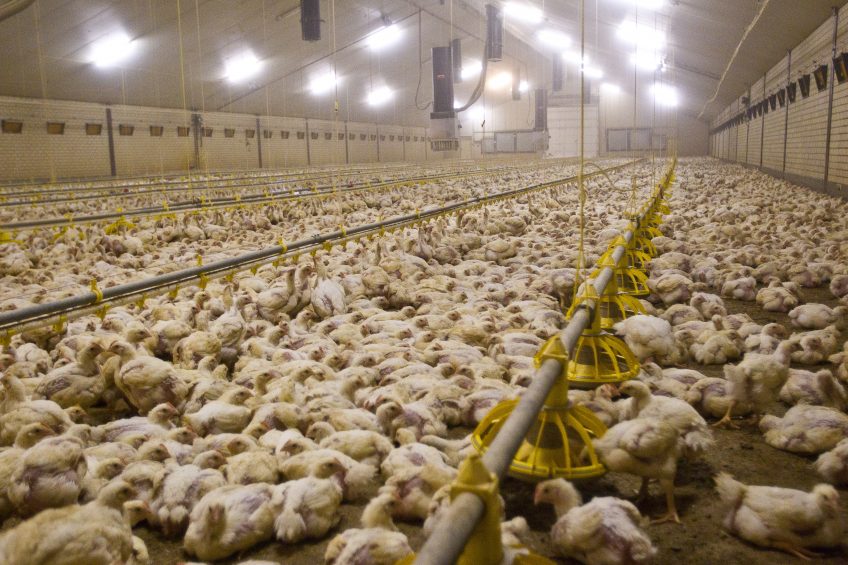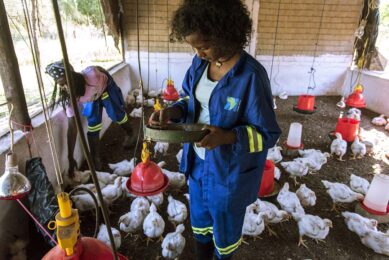Gut health without coccidiostats or antibiotics

As coccidiostats can induce bacterial resistance and may be banned as feed additives in the EU, alternatives are needed. Alpha-monoglycerides are able to overcome the negative effects on broiler performance caused by Eimeria and Clostridia and improve uniformity within the flock. Furthermore, antibiotics are susceptible to imposing restrictions. Alpha-monoglycerides can be a tool to lower and potentially replace the use of antibiotics.
Antibiotics and coccidiostats have been widely used in animal production for many decades. Most of the antibiotics were given for prophylactic purposes as antimicrobial growth promoters (AGPs), which improved growth and feed conversion ratio. Others were used as a therapeutic treatment to improve animal health. In 2006, the use of antibiotics as AGPs were banned, but coccidiostats are still available as feed additives.
Nowadays, 11 coccidiostats are approved in the European Union to be used in broilers. Six of them are ionophores and five are chemicals. It is well known that ionophore coccidiostats also have antibacterial effects. Scientific studies show that bacterial resistance and cross-resistance exist between ionophore coccidiostats, especially against enterococci. Furthermore, resistance of coccidia against all 11 coccidiostats has been reported. Rotation and shuttle programmes are developed to reduce the risk of resistance and the presence of necrotic enteritis (NE).
Indeed, the presence of a mild coccidiosis infection is a prerequisite to result in a necrosis of the intestinal mucosa by Clostridium perfringens. This can lead to a higher usage of therapeutic antibiotics. Coccidiostats were intended to be prohibited as a feed additive from 2012. However, vaccination and other feed additives tested could not fully replace the coccidiostats and the proposal was cast aside. Currently, EFSA is evaluating the use of coccidiostats as a feed additive again, as the expiry dates of authorisation approaches. A feed additive which can reduce the presence of C. perfringens and the negative health effects of NE in the absence of a coccidiostat would therefore be right on time. Furthermore, with an increase in resistant bacteria against the most commonly used antibiotics, an antimicrobial feed additive is needed.
Alpha-monoglycerides as an antimicrobial feed ingredient
Alpha-monoglycerides are a class of glycerides that are composed of a fatty acid linked to the sn1-position of a glycerol molecule via an ester bond and are known for their strong antimicrobial effects. Depending on the chain length of the fatty acid, different α-monoglycerides can be produced. A distinction can be made between α-monoglycerides of short chain fatty acids (SCFA) and α-monoglycerides of medium chain fatty acids (MCFA), which have different characteristics. Alpha-monoglycerides of SCFA such as α-monopropionin and α-monobutyrin, are mainly active against gram negative bacteria. In contrast, α-monoglycerides of MCFA like α-monocaprylin, α-monocaprin and α-monolaurin are more efficient against gram positive bacteria. Multiple studies have been conducted which prove the antibacterial effect of α-monoglycerides in vitro and in vivo. In addition, scientific literature describes the potential antiviral properties of α-monoglycerides of MCFA, and more particularly α-monolaurin.
The strong covalent bond of α-monoglycerides results in multiple benefits compared to free fatty acids. Alpha-monoglycerides are pH independent and consequently do not dissociate. They are non-volatile, non-corrosive and heat stable during feed processing. Furthermore, research has shown that α-monoglycerides have a much stronger antimicrobial effect compared to their corresponding free fatty acids. Consequently they are active in four different environments: water, feed, gizzard, and the intestinal tract.
Figure 1 – FCR and weight gain showed in a boxplot for the five experimental groups.

Effects on Eimeria and Clostridia infections
FRAmelco has developed FRA Gut Balance Dry; a combination of α-monobutyrin, α-monopropionin, α-monocaprylin and α-monocaprin. The product is designed to stimulate overall gut health by inhibiting the growth of gram-negative and gram-positive bacteria. In a challenge trial with Eimeria (10-fold overdose of Paracox-5 at day 18) and C. perfringens from the environment, the effects of FRA Gut Balance Dry and other feed additives were tested. A total of 4400 one-day-old broilers were divided over five groups with 11 repetitions of each 80 broilers. The negative control group received no coccidiostats or feed additives. The positive control group received 70 ppm of Narasin in the grower feed. Treatment group 1 received 3 kg of FRA Gut Balance Dry per ton of feed the first 14 days and 2.5 kg per ton of feed from day 15 till day 28. Treatment group 2 and 3 received feed additive A and B respectively. At day 28 of age the footpad lesions, FCR and growth were determined.
Figure 1 shows that the FCR is significantly improved in treatment group 1 when adding α-monoglycerides to the diet compared to the negative control (1.350 vs 1.383, p=0.0038). This median is comparable with the FCR of the positive control group with Narasin (1.347). Figure 1 also shows that feeding broilers α-monoglycerides resulted in the highest weight gain, expressed as median, compared to the other two feed additives. Also the final weight was more uniform in the group receiving FRA Gut Balance Dry. Figure 2 shows that only Narasin and the α-monoglycerides significantly reduced the footpad lesion score from 5 till 0.
Figure 2 – Footpad score for the five experimental groups.

Antibiotics
The impact of phasing out the AGPs on poultry health could be held under control due to alternative husbandry practices, other antimicrobial feed additives, the use of ionophore coccidiostats and veterinary use of antibiotics. Now the coccidiostats are under evaluation, the use of antibiotics or alternatives become even more necessary. However, more restrictions and regulations are defined for the use of antibiotics in food-producing animals. Resistant genes of bacteria have been found in livestock and humans, which mean that treating human diseases with antibiotics become more often a challenge.
For example, colistin has been used for over 50 years in both animals and humans. In the EU it is in the top five of antibiotics used in animals. This is partly due to resistance against other antibiotics. In human medicine it is one of the last antibiotics to treat humans with a bacterial infection also resistant to other antibiotics. However, colistin resistance is increasing, mediated by the mcr-1 gene. This mcr-1 gene was found in bacteria isolated from food-producing animals, food, humans and the environment. This indicates a possible transmission between these factors. The European Commission requested the European Medicines Agency to update its advice on the use of colistin in animals.
Alpha-monoglycerides can help to gradually lower or potentially replace antibiotics. In 2013 Manohar et al. published a study showing that alpha-monolaurin had a better minimum inhibitory concentration and minimum bactericidal concentration against two strains of Staphylococcus aureus compared to different antibiotics. Alpha-monolaurin has even shown to be active against an antibiotic resistant strain of Staphylococcus.
Join 31,000+ subscribers
Subscribe to our newsletter to stay updated about all the need-to-know content in the poultry sector, three times a week. Beheer
Beheer








 WP Admin
WP Admin  Bewerk bericht
Bewerk bericht